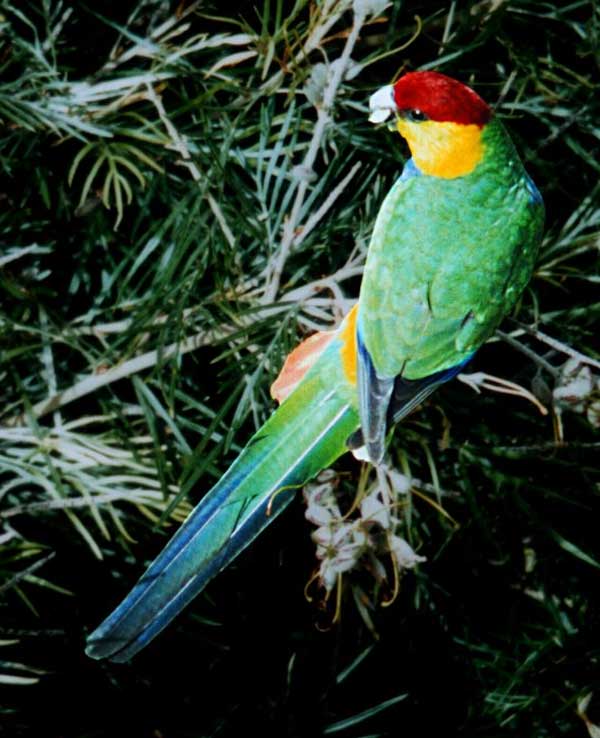Purpureicephalus spurius (*) Cladus: Eukaryota Name Purpureicephalus spurius (Kuhl, 1820) Vernacular name The Red-capped Parrot (Purpureicephalus spurius), also called the Pileated Parakeet[1] (leading to easy confusion with the South American Pionopsitta pileata), and King Parrot locally in Western Australia,[2] is an Australian species of broad-tailed parrot related to the Rosellas. First described by German naturalist Heinrich Kuhl in 1820, from a collection in Albany, Western Australia,[3] the Red-capped Parrot was placed in the monotypic genus Purpureicephalus by Charles Lucien Bonaparte in 1854. The generic name is an amalgam of the Latin purpureus "purple", and the Ancient Greek kephalos "head". The specific epithet spurius is the Latin adjective meaning "illegitimate", and refers to the very different adult and immature plumages (hence appearing unrelated).[3] Besides Red-capped Parrot, vernacular names include Pileated Parrot, Western King Parrot, Purple-crowned Parrot, Grey Parrot or Hookbill.[3] Measuring 34–38 cm (14–15 in) in length and weighing 105–125 g, the adult Red-capped Parrot is a distinctive and easily recognised medium-sized parrot. The adult male has a crimson crown, grey-brown lores, and green-yellow cheeks and a narrow long upper mandible. The upperparts are dark green, the rump yellow-green, the tail green with dark blue tip.[3] The underparts are purplish-blue and the flanks green and red. The female is similar but duller overall, and the juvenile has a dark green crown, reddish frontal band, and red-brown underparts.[4] The species occurs from the Moore River southwards in southwestern Australia. Its natural habitat is Marri (Corymbia calophylla), but has adpated to farmland, orchards and suburban landscapes in Perth.[4] Marri seeds are the preferred diet, but birds also extract seeds from Karri (Eucalyptus marginata), woody pear (Xylomelum), Grevillea, Hakea, and She-oak (Casuarina), as well as insects such as psyllids, and even orchard fruit such as apples and pears.[4] The breeding season is August to December, the nest is a tree hollow, and a clutch of five white [[bird egg|egg\\s is laid. References 1. ^ Alderton, David (2003). The Ultimate Encyclopedia of Caged and Aviary Birds. London, England: Hermes House. p. 187. ISBN 184309164X. * BirdLife International (2004). Purpureicephalus spurius. 2006. IUCN Red List of Threatened Species. IUCN 2006. www.iucnredlist.org. Retrieved on 11 May 2006. Database entry includes justification for why this species is of least concern Source: Wikipedia, Wikispecies: All text is available under the terms of the GNU Free Documentation License |
|

